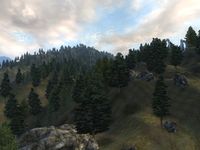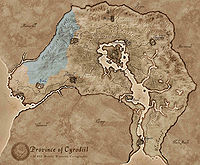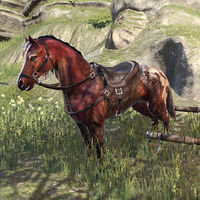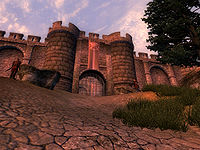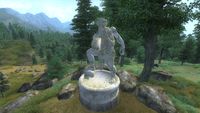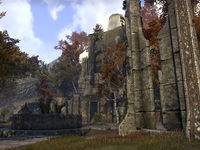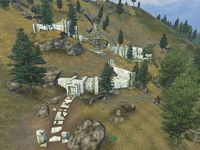Lore:Colovian Highlands
| Colovian Highlands | |
|---|---|
| Type | Region |
| Continent | Tamriel |
| Province | Cyrodiil |
| Subregions | Battlehorn Imperial Reserve |
| Demonym(s) | Highlander[1] |
| Appears in | Oblivion, ESO |
The Colovian Highlands are a hilly, forested region on the northwest outskirts of Colovia and the province of Cyrodiil. The region is known for its ancient forest,[2] and prominent wine country, specifically for its famously robust red blends.[3] The Colovian Highlands are a far-off region from the centers of Imperial civilization but some people, such as the well-known Imperial historian Dubicius call the region their home.[4]
The Colovian Highlands runs along the northwest provincial border, between the southern-innermost banks of the Brena River, the western Imperial Reserve, and the westernmost Jerall Mountains. Colovian cities such as Chorrol and Kvatch lie on the edge of their respective regions before they lead into the highlands, but their county districts extend out there. The Black Road, one of Cyrodiil's major colored thoroughfares runs through the Colovian Highlands before it disappears into the mountains.[5]
Society and Geography[edit]
The Snow-Blanket Sorrel Horse is native to the Colovian Highlands, as well as a common sight between Chorrol and Bruma. It is known for its intelligence and high spirits.[6] The Highland Spotted Lynx is a species native to the region. They were previously uncommon, but an opportunistic hunter brought cubs with him and they have since become premium vermin killers in the area.[7][8] The brown Highland Wolf is a common creature found between here and the Great Forest. Local farmers and shepherds fear their wild packs, but some foresters have domesticated them and turned them into mounts.[9]
A Colovian Highland style of ale is strong and sweet, with just a taste of juniper. By the early Fourth Era, it was popular all over Colovia but it was seldom seen in Nibenay.[10]:Part 2, Chapter 7
History[edit]
The Colovian Highlands are riddled with rocky trails, caves, and woodlands with scant examples of civilization. The more south you travel, the more ruins, specifically Ayleid ruins can be found. The exact history of these ruins before abandonment is unknown, but the clans of the former cities, Talwinque and Varondo were able to escape the Nedes during the Alessian Slave Rebellion and found refuge among the Bosmer during the Ayleid Diaspora.[11]
Some of the forts date back to the early First Era, when Colovia was ruled by kingdoms such as Kvatch. In one of Colovia's many incursions into Reaper's March, the Hastrel, Linchal, and Ontus cohorts led by the famed General Thibaut of Kvatch traveled south into the region. The details of Thibaut's death are unknown but while the Linchal and Ontus cohorts returned north, the Hastrel cohort stayed and built the modern-day township, Greenhill.[12]
After his successful ambush against Emperor Gorieus in a low-barring pass, King Rislav Larich of Skingrad and his Colovian forces fled north through the West Weald and eventually, the Colovian Highlands with the Imperial Army following suit. In the highland forest, Gorieus and his exhausted army was confronted by King Justinius of Kvatch, Rislav's father-in-law, and were defeated within an hour. Disheveled, the Imperial Army fled north into the Imperial Reserve and eventually back into the Nibenay.[2]
When the Alliance War broke out and sundered central Cyrodiil, the Daggerfall Covenant advanced onto the region through the Jerall Mountains and the Colovian Highlands. The Covenant built their southern gate stronghold on the edge of the Colovian Highlands west of Lipsand Tarn and Fort Rayles,[13] as well as a temple to house the Elder Scroll of Alma Ruma.[14] Central Cyrodiil was split three ways between the alliances with the northwest taken over by the Daggerfall Covenant. With that being said, only a fraction of the Colovian Highlands fell inside the border, only around Hrotanda Vale and the aforementioned Lipsand Tarn.[15] At the time there was a rumor of plague in the highlands.[16]
Before the Battle of the Red Ring in the Great War, General Decianus and his Imperial Legion from Hammerfell were amassed in the Colovian Highlands, near Chorrol while Emperor Titus Mede II and General Jonna's armies were gathered. On the 30th of Rain's Hand, General Decianus descended onto the Imperial City from the west, taking Lord Naarifin by surprise while Jonna's forces were counterattacked from the south by the Aldmeri Dominion. In the end, the Imperial Army was able to re-capture the Imperial City and seize the war from the Dominion.[17]
Notable Locations[edit]
- Battlehorn Castle
- The last stronghold of the Knights of the True Horn, held by the order until their demise in the twilight years of the Third Era.
- Cloud Top
- A mountain summit in the Colovian Highlands.
- Fort Linchal
- A former Imperial outpost and a historical location established back when Kvatch was a kingdom.
- Lipsand Tarn
- Known as the Elfs Haunts to the locals of nearby Chorrol, it is a ruin built into the hills that people tend to avoid.
- Shrine of Sanguine
- The province's shrine to the Daedric Prince of Debauchery and Revelry.
- Talwinque
- A large Ayleid ruin northeast of Kvatch, whose clan managed to avoid the Alessian Slave Rebellion and flee south into Valenwood.
Gallery[edit]
See Also[edit]
- For game-specific information, see the Oblivion and Elder Scrolls Online
 articles.
articles.
References[edit]
- ^ Gureryne Selvilo's dialogue in Oblivion
- ^ a b Rislav The Righteous — Sinjin
- ^ Wines of Blackwood — Orius Hertano
- ^ Castles and Coffers Volume III: Hel Ra Citadel
- ^ Map of the Colovian Highlands – The Elder Scrolls IV: Oblivion
- ^ Snow-Blanket Sorrel Horse mount description in ESO
- ^ Highland Spotted Lynx Bundle description in ESO
- ^ Highland Spotted Lynx mount description in ESO
- ^ Highland Wolf mount description in ESO
- ^ The Infernal City — Greg Keyes
- ^ Ayleid Survivals in Valenwood — Cuinur of Cloudrest, 4th Tier Scholar of Tamrielic Minutiae
- ^ Thibaut's Cairn and its History — Charonius of Sutch
- ^ Southern High Rock Gate location in ESO
- ^ Protector Yseline's dialogue in ESO
- ^ Daggerfall Territory sub-region in ESO
- ^ Madam Firilanya's letters in ESO
- ^ The Great War — Legate Justianus Quintius
